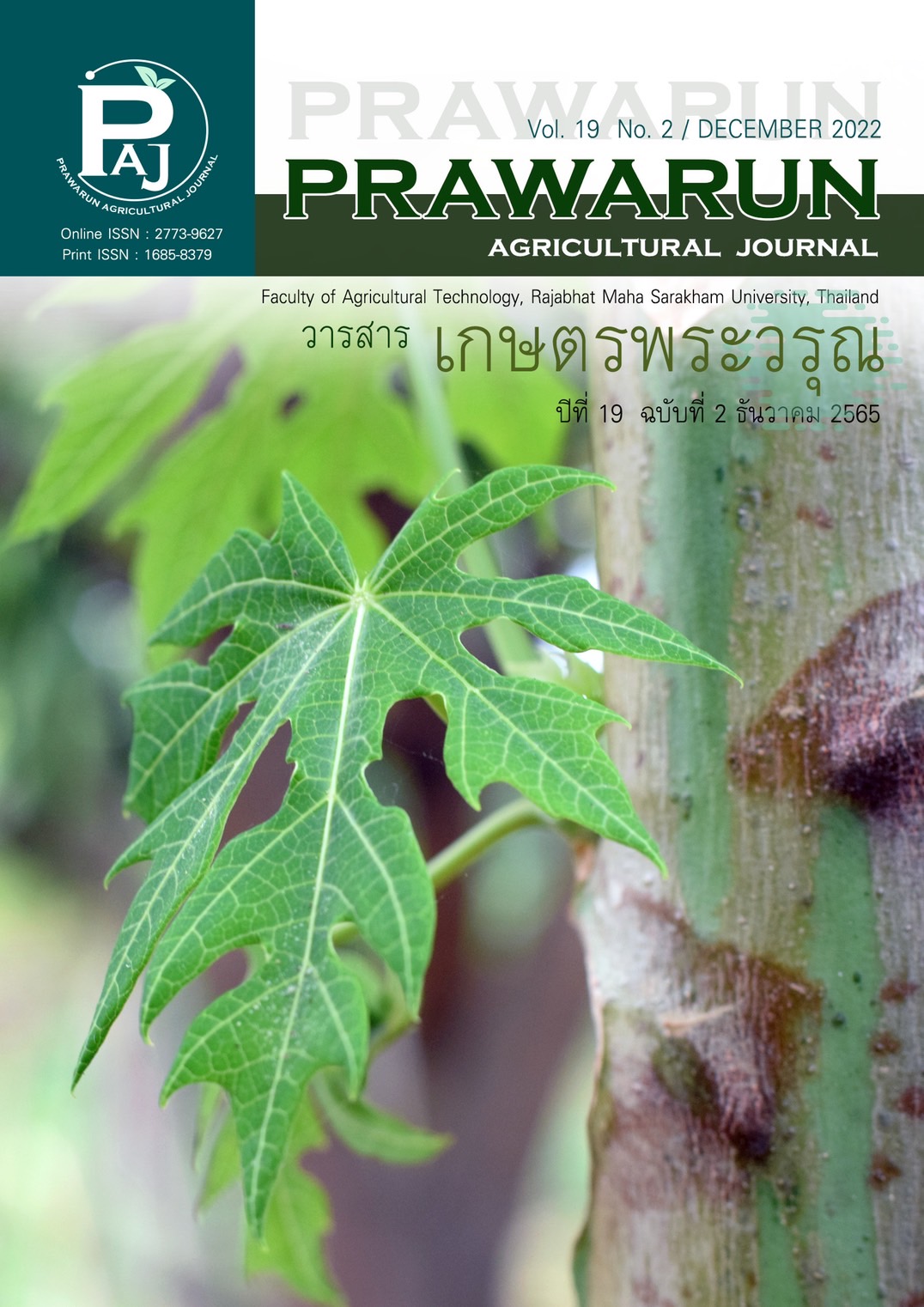ความคงตัวของสีและการเกิดออกซิเดชั่นของเนื้อระหว่างการเก็บเย็นจากไก่เนื้อที่ได้รับการเสริมผลมังเคร่ในน้ำดื่ม
Main Article Content
บทคัดย่อ
การทดลองนี้มีวัตถุประสงค์เพื่อศึกษาคุณภาพเนื้อระหว่างการเก็บเย็นของเนื้อไก่ที่ได้รับการเสริมผลมังเคร่ในน้ำดื่ม ได้แก่ ความคงตัวของสี การเกิดออกซิเดชั่นและความสามารถในการต้านอนุมูลอิสระ โดยนำเนื้อส่วนหน้าอกของไก่เนื้อที่ได้รับน้ำดื่มเสริมผลมังเคร่แห้งบดละเอียดที่ระดับ 0, 1 และ 2% แต่ละกลุ่มการทดลองมี 4 ซ้ำๆ ละ 10 ตัว ใช้ไก่เนื้อสายพันธุ์ทางการค้าอายุ 14 วัน จำนวน 120 ตัว ทำการเลี้ยงไก่ในโรงเรือนเปิด ให้อาหารและน้ำแบบเต็มที่จนไก่เนื้อมีอายุ 38 วัน ผลการทดลองพบว่าการเสริมมังเคร่ในน้ำดื่มไม่มีผลต่อ ค่า L*, a*, Hue, %MetMb และความสามารถในการต้านอนุมูลอิสระของเนื้อไก่ในวันที่ 0, 3 และ 6 ของการเก็บเย็น (P>0.05) อย่างไรก็ตามการเสริมมังเคร่ในน้ำดื่มที่ระดับ 1% ทำให้ค่า Chroma ในเนื้อไก่สูงที่สุด และการเสริมมังเคร่ที่ระดับ 1 และ 2% ทำให้การเกิดออกซิเดชั่นของไขมันสูงขึ้นเมื่อเทียบกับกลุ่มควบคุม ในวันที่ 0 ของการเก็บเย็น (P<0.05) แต่ไม่แตกต่างกันในวันที่ 3 และ 6 ของการเก็บเย็น ดังนั้นจึงสรุปได้ว่าการเสริมผลมังคร่บดในน้ำดื่มที่ระดับ 1% อาจช่วยทำให้เนื้อไก่มีค่าความอิ่มตัวของสีดีขึ้น
Article Details
เอกสารอ้างอิง
Aziz, N., Mat Nor, N. A., Mohd Adnan, A. F., Taha, R. M., & Arof, A. K. (2012). Study of anthocyanin stability derived from the fruit pulp of Melastoma malabathricum in a coating system. Pigment and Resin Technology, 41(4), 223–229. doi: http://doi.10.1108/03699421211242455.
Eghbaliferiz, S., & Iranshahi, M. (2016). Prooxidant activity of polyphenols, flavonoids, anthocyanins and carotenoids: updated review of mechanisms and catalyzing metals. Phytotherapy Research, 30(9), 1379-1391.
Hunter, R. S., & Harold, R. W. (1987). The measurement of appearance (2nd ed.). New York: John Wiley-Inter science.
Kasunmala, I. G. G., Navaratne, S. B., & Wickramasinghe, I. (2020) Antioxidant activity and physicochemical properties changes of Melastoma malabathricum (L.) and Syzygium caryophyllatum (L.) fruit during ripening. International Journal of Fruit Science, 20(Suppl. 3), S1819-S1828. doi: 10.1080/15538362.2020.1834896.
Kropf, D. H. (2003). Enhancing meat color stability. Proceedings of the 56th American meat science association reciprocal meat conference (pp. 73-75). Columbia: Missouri.
Krzywicki, K. (1979). Assessment of relative content of myoglobin, oxymyoglobin and metmyoglobin at the surface of beef. Meat Science, 3(1), 1-10. doi: 10.1016/0309-1740(79)90019-6.
Lindahl, G., Lundstrom, K., & Tornberg, E. (2001). Contribution of pigment content, myoglobin forms and internal reflectance to the colour of pork loin and ham from pure breed pigs. Meat Science, 59(2), 141–151. doi: 10.1016/s0309-1740(01)00064-x.
Mancini, R. A., & Hunt, M. C. (2005). Current research in meat color. Meat science, 71(1), 100–121. doi: 10.1016/j.meatsci.2005.03.003.
Monino, I., Martínez, C., Sotomayor, J. A., Lafuente, A., & Jordán, M. J. (2008). Polyphenolic transmission to Segureno lamb meat from ewes’diet supplemented with the distillate from rosemary (Rosmarinus officinalis) leaves. Journal of Agricultural and Food Chemistry, 56(9), 3363-3367.
Morrissey, P. A., Sheehy, P. J., Galvin, K., Kerry, J. P., & Buckley, D. J. (1998). Lipid stability in meat and meat products. Meat Science, 49 (Suppl. 1), S73-S86.
Omar, S. N. C., Abdullah, J. O., Khairoji, K. A., Chin, S. C., & Hamid, M. (2013). Effects of flower and fruit extracts of Melastoma malabathricum Linn. on growth of pathogenic bacteria: Listeria monocytogenes, Staphylococcus aureus, Escherichia coli, and Salmonella typhimurium. Evidence-Based Complementary and Alternative Medicine, 2013(2):459089. doi: 10.1155/2013/459089.
Omar, S. N. C., Abdullah, J. O., Khairoji, K. A., Chin, S. C., & Hamid, M. (2012). Potentials of Melastoma malabathricum Linn. flower and fruit extracts as antimicrobial infusions. American Journal of Plant Sciences, 3(8), 1127-1134. doi: 10.4236/ajps.2012.38136.
Park, J. H., Kang, S. N., Shin, D., & Shim, K. S. (2015). Antioxidant enzyme activity and meat quality of meat type ducks fed with dried Oregano (Origanum vulgare L.) powder. Asian-Australasian Journal of Animal Sciences, 28(1), 79-85. doi: 10.5713/ajas.14.0313.
Pastsart, U. (2019). Effect of Melastoma malabathricum supplementation in drinking water on growth performance, carcass and meat quality of broilers. Khon Kaen Agriculture Journal, 47(Suppl. 1), 769-774. (in Thai)
Pastsart, U., De Boever, M., Claeys, E., & De Smet, S. (2013). Effect of muscle and post-mortem rate of pH and temperature fall on antioxidant enzyme activities in beef. Meat science, 93(3), 681–686. doi: 10.1016/j.meatsci.2012.11.008.
Pastsart, U., Nakawiroj, P., Pimpa, O., Rattanawut, J., & Khamseekhiew, B. (2021). Antioxidant capacity and lipid oxidation in meat during cold storage of broilers fed with sweet basil (Ocimum basilicum) leaves. Khon Kaen Agriculture Journal, 49(Suppl. 2), 862-866. (in Thai)
Qwele, K., Hugo, A., Oyedemi, S. O., Moyo, B., Masika, P. J., & Muchenje, V. (2013). Chemical composition, fatty acid content and antioxidant potential of meat from goats supplemented with Moringa (Moringa oleifera) leaves, sunflower cake and grass hay. Meat Science, 93(3), 455–462.
Renerre, M., Dumont, F., & Gatellier, P. (1996). Antioxidant enzyme activities in beef in relation to oxidation of lipid and myoglobin. Meat Science, 43(2), 111–121. doi: 10.1016/0309-1740(96)84583-9.
Sharma, O. P., & Bhat, T. K. (2009). DPPH antioxidant assay revisited. Food chemistry, 113(4), 1202-1205.
Song, F. L., Gan, R. Y., Zhang, Y., Xiao, Q., Kuang, L., & Li, H. B. (2010). Total phenolic contents and antioxidant capacities of selected Chinese medicinal plants. International journal of molecular sciences, 11(6), 2362-2372. doi: 10.3390/ijms11062362.
Susanti, D., Sirat, H. M., Ahmad, F., Ali, R. M., Aimi, N., & Kitajima, M. (2007). Antioxidant and cytotoxic flavonoids from the flowers of Melastoma malabathricum L. Food Chemistry, 103(3), 710-716.
Tarladgis, B. G., Watts, B. M., Younathan, M. T., & Dugan, L. (1960). A distillation method for the quantitative determination of malonaldehyde in rancid foods. Journal of the American Oil Chemists' Society, 37, 44–48.
Wang, L., Guo, H., Liu, X., Jiang, G., Li, C., Li, X., & Li, Y. (2019). Roles of Lentinula edodes as the pork lean meat replacer in production of the sausage. Meat science, 156(1), 44-51. doi: 10.1016/j.meatsci.2019.05.016.
Yao, Y., Sang, W., Zhou, M., & Ren, G. (2010). Phenolic composition and antioxidant activities of 11 celery cultivars. Journal of Food science, 75(1), C9-C13. doi: 10.1111/j.1750-3841.2009.01392.x.
Zakaria, Z. A., Rofiee, M. S., Mohamed, A. M., Teh, L. K., & Salleh, M. Z. (2011). In vitro antiproliferative and antioxidant activities and total phenolic contents of the extracts of Melastoma malabathricum leaves. Journal of Acupuncture and Meridian Studies, 4(4), 248-256. doi: 10.1016/j.jams.2011.09.016.


